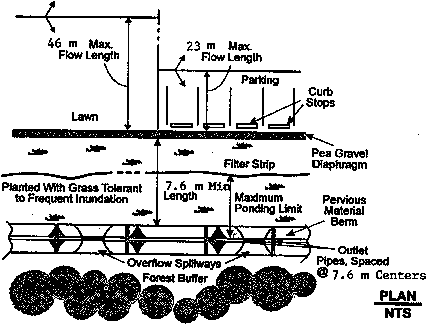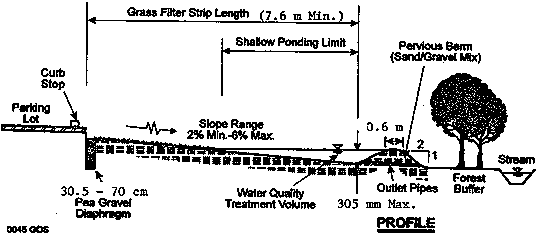Stormwater Best Management Practices in an Ultra-Urban Setting: Selection and Monitoring
Fact Sheet - Filter Strips
Filter strips, also known as vegetated buffer strips, use biological and chemical processes to filter stormwater runoff. Water flows in a sheet across the vegetated area, and is treated by infiltration into the soil and uptake by plants (Figure 20). Small berms may be installed at the downslope edge of the filter strip so that the water can be detained and infiltrated into the underlying soils.


Filter strips are not designed to attenuate peak stormwater flows, but can be an effective water quality measure. A dense vegetative cover, long flow length, and low gradient provide the most efficient removal rates.
Applicability
Filter strips are appropriate only where ample room exists for installation. There must be sufficient flow length and gradient to adequately treat the stormwater. In the ultra-urban environment, they have limited application due to the required flow length. The primary highway application for vegetative filter strips is along rural roadways where runoff that would otherwise discharge directly to a receiving water first passes through a filter strip before entering a conveyance system (WSDOT, 1995).
A filter strip is commonly operated as a pre-treatment BMP located upstream of other BMPs capable of greater pollutant removal rates. As a stand-alone BMP, filter strips can only treat the lowest intensity rainfall events. While providing water quality treatment for small frequent storms, filter strips operating as on-line facilities must still retain the ability to convey high runoff rates from the roadway when high-intensity storms occur. Filter strips cannot treat high-velocity flows and do not provide enough storage or infiltration to effectively reduce peak discharges to predevelopment levels (Schueler, 1992).
By design, filter strips are relatively flexible BMPs; the gradient, width, and length can be set based on local constraints. In most applications, filter strips are placed perpendicular to roadways and, therefore, may make highways safer by providing stopping distance for any vehicles that may leave the roadway. Filter strips are practically vandal-proof and add an aesthetic value to roadside areas as long as they are maintained and litter and debris are regularly removed. In most cases, however, site constraints will restrict their use in ultra-urban areas.
Effectiveness
There is relatively little data on the effectiveness of filter strips on urban stormwater runoff. In one study, moderate to high removal rates were found for a 45.7-m-long (150-ft-long) grass filter strip treating urban runoff, but only mediocre pollutant removal occurred with a 22.9-m-long (75-ft-long) grass filter strip (Yu et al., 1993). Slope length and slope are also related to sediment removal efficiency (Wong and McCuen, 1982). These results are different from applications in agriculture, where much shorter grass strips have been found to work acceptably for agricultural runoff. Additional data on pollutant removal effectiveness is shown in Table 16.
Table 16. Pollutant removal effectiveness for filter strips (%)
| Study |
TSS |
TP |
NO3 |
Lead |
Zinc |
Comments |
| Yu and Kaighn (1992) |
27 |
22 |
6 |
2 |
17 |
18-foot flow length1 |
| |
67 |
22 |
8 |
18 |
46 |
50-foot flow length |
| |
68 |
33 |
9 |
20 |
50 |
150-foot flow length |
| 1 Flow length is distance traveled uphill to downhill on surface of the filter strip. |
Pretreatment is not considered crucial to the removal performance of filter strips unless there is sufficient loading of pollutants (e.g., sand, oil and grease) to harm the vegetated surface. Designers should note that field surveys indicate many filter strips lack good vegetative cover, are subject to excessive sediment deposition, or are short-circuited by channels formed by concentrated flow (i.e., rill development). This is particularly true for filter strips employed in urban areas, where runoff concentrates very quickly (Claytor and Schueler, 1996). Furthermore, it is expected that there will be seasonal differences in filter strip performance in seasonal climates, where plant growth will be dormant and thinned. Cold winter temperatures will freeze the soil surface and prevent runoff infiltration into soils. Filter strips are not recommended for arid areas where sustaining growth is difficult.
Filter strips provide relatively low rates of pollutant removal and are most effective for total suspended solids (TSS), with approximately 70 percent removal. It has been estimated that filter strips can remove approximately 10 percent of total phosphorus (TP), 30 percent of total nitrogen (TN), and between 40 and 50 percent of suspended metals. During large rainfall events, filter strips provide marginal treatment and may in fact become sources of erosion.
Siting and Design Considerations
The most important features of the filter strip that dictate effectiveness are the slope of the vegetated surface, the length of the vegetated surface, the uniformity of the surface, and the density of plant growth.
First, slope constraints exist for filter strips; most sources recommend that the surface slope be between two and six percent (Claytor and Schueler, 1996). Designers should note that with steeper slopes it becomes difficult to meet other design recommendations such as having a peak flow velocity of 0.27 m/s (0.9 ft/s) and a desired hydraulic residence time of nine minutes (Young et al., 1996). In addition, there are suggested flow length limits for filter strips, such as a minimum flow length (uphill to downhill) of 7.6 m (25 ft) (Claytor and Schueler, 1996). Field monitoring found that limited pollutant removal occurred in an urban application when the flow length was 23 m (75 ft); moderate to high removal of pollutants was found to occur for a filter strip with twice the flow length (45.7 m [150 ft]).
There are also recommended limits on the size of the service area served by the filter strip. The maximum recommended overland flow distance starting at the uphill edge of the filter strip and going uphill in the service area should not be more than 23 m (75 ft) for an impervious service area or 45.7 m (150 ft) for a pervious service area. However, various states have developed local limits or design requirements for filter strips. The Washington State Department of Transportation suggests that filter strips be used to treat runoff from roadways with a maximum of two lanes, and for a roadway with average daily traffic of less than 30,000 vehicles (WSDOT, 1995). The Colorado Department of Transportation sets the maximum flow depth on the filter strip at 0.64 cm (0.25 in) (CDOT, 1992).
To be effective, filter strips require sheet flow across the entire strip. Once flow concentrates to form a channel, it effectively short-circuits the filter strip. Unfortunately, this usually occurs within a short distance for filter strips in urban areas. It is difficult to maintain sheet flow over a distance of 45.7 m (150 ft) for pervious areas and 23 m (75 ft) for impervious areas. This may be due in part to the inability to obtain evenly compacted and level soil surfaces using common construction methodology. For some applications, a level spreader can be used to help ensure even distribution of stormwater onto the filter strip. To help maintain a uniform soil surface, some designs divert runoff from storms greater than the 2-year rainfall around the filter strip to avoid erosion and rill development.
During the construction phase, the topsoil should be of good quality and the subsoil should be tilled to reduce erosion and promote establishment of vegetation. Soil amendments such as lime, fertilizer, and organic material may be required.
Designers considering the application of filter strips can roughly estimate they need a filter strip 177 m (580 ft) wide by 23 m (75 ft) long (uphill to downhill) to manage a 0.4 ha (1 ac) service area (100 percent imperviousness). For those seeking design examples and additional information, several good sources are available, including Design of Stormwater Filtering Systems (Claytor and Schueler, 1996), Urban Drainage Design Manual Hydraulic Engineering Circular 22 (Brown et al., 1996), Evaluation and Management of Highway Runoff Water Quality (Young et al., 1996), and Highway Runoff Manual (WSDOT, 1995).
Maintenance Considerations
In general, maintenance efforts and costs for filter strips are small. Periodic maintenance for filter strips is primarily focused on ensuring a vigorous and healthy plant growth, preventing the formation of rills and gullies, and removing debris and litter. Of these items the most significant, costwise, is periodic mowing to keep grasses at acceptable levels and to minimize the growth of successional vegetation. It is recommended that mowing be performed perpendicular to the slope to help minimize the development of rills. For filter strips, it is important to avoid the use of herbicides and fertilizers on grassed portions of the strip, since these applications can directly contribute undesirable pollutants to waterways.
Filter strips can last for 10 to 20 years with proper conditions and regular maintenance. Proper maintenance is defined as those operations needed to ensure that uniform sheet flow and dense vegetation are maintained. For example, in locations where sanding of roadways or parking lot areas occur, it may be necessary to scrape away sediment build-up at the edge of the pavement to maintain even inflow to the filter strip. It is also recommended that maintenance of the filter strip be performed twice a year to patch any bare spots and fill and replant any rills that are forming.
Cost Considerations
Filter strips are low-cost BMPs. The principal cost to install is related to earth moving construction costs and planting costs. The cost for vegetative establishment, in 1995 dollars, is approximately $5,000 per ha ($2,000 per ac) for establishing an area by hydroseeding (Schueler, 1987). This does not include real estate, design, and contingency costs. Costs for sodding and planting of woody vegetation are significantly higher. (Note, that this unit cost value should be used for conceptual cost estimating only.)
References
Brown, S.A., S.M. Stein, and J.C. Warner. 1996. Urban Drainage Design Manual Hydraulic Engineering Circular 22. FHWA-SA-96-078. Federal Highway Administration, Office of Technology Applications.
Claytor, R.A., and T.R. Schueler. 1996. Design of Stormwater Filtering Systems. The Center for Watershed Protection, Silver Spring, MD.
Colorado Department of Transportation (CDOT). 1992. Erosion Control and Stormwater Quality Guide. Colorado Department of Transportation.
Driscoll, E., and P. Mangarella. 1990. Urban Targeting and BMP Selection. Prepared by Woodward-Clyde Consultants, Oakland, CA, for U.S. Environmental Protection Agency, Washington, DC.
Schueler, T.R. 1987. Controlling Urban Runoff: A Practical Manual for Planning and Designing Urban BMPs. Metropolitan Washington Council of Governments, Washington, DC.
Schueler, T.R., P.A. Kumble, and M.A. Heraty. 1992. A Current Assessment of Urban Best Management Practices - Techniques for Reducing Non-Point Source Pollution in the Coastal Zone. Metropolitan Washington Council of Governments, Department of Environmental Programs, Anacostia Restoration Team, Washington, DC.
Urbonas, B.R., J.T. Doerfer, J. Sorenson, J.T. Wulliman, and T. Fairley. 1992. Urban Storm Drainage Criteria Manual. Vol. 3. Best Management Practices, Stormwater Quality. Urban Drainage and Flood Control District, Denver, CO.
Washington State Department of Transportation (WSDOT). 1995. Highway Runoff Manual. Washington State Department of Transportation.
Wong, S.L., and R.H. McCuen. 1982. The Design of Vegetative Buffer Strips for Runoff and Sediment Control. Appendix J in Stormwater Management for Coastal Areas. American Society of Civil Engineers, New York, New York.
Young, G.K., S. Stein, P. Cole, T. Kammer, F. Graziano, and F. Bank. 1996. Evaluation and Management of Highway Runoff Water Quality. FHWA-PD-96-032. Federal Highway Administration, Office of Environment and Planning.
Yu, S.L., S.L. Barnes, and V.W. Gerde. 1993. Testing of Best Management Practices for Controlling Highway Runoff. Virginia Transportation Research Council, Charlottesville, VA.
Yu, S.L., and R.J. Kaighn. 1992. VDOT Manual of Practice for Planning Stormwater Management. Federal Highway Administration, FHWA/VA-92-R13, Virginia Department of Transportation, Virginia Transportation Research Council, Charlottesville, VA.
|

